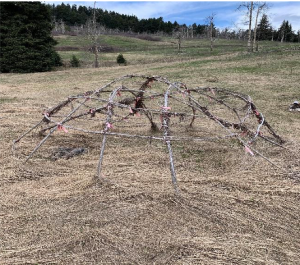Stepping Stone 4: Indigenous Health and Wellness in the 21st Century
by Dr. Rosalin Miles
Introduction

When considering Indigenous health and wellness from a Colonial or Western approach, there tends to be an initial fixation on the issues that plague the population. What are the illnesses, diseases, and troubles that may be prevalent? This deficits-based approach to health and wellness occurs when there is a primary focus on problems that may be present within a population. For the past century, colonial medicine has been concentrated on disease and disease treatment instead of prevention and the promotion of wholistic health and wellness. Describing a population based on disease and associated issues is discouraging and de-motivational as it creates shame around belonging to a group or community. Our current healthcare system lacks access that is culturally appropriate, such as including traditional healing methods, and it lacks a foundation of strength-based perspectives. This Stepping Stone will examine Indigenous health and wellness from a strength-based perspective.
Wholistic Learning Objectives
Stepping Stone 4 invites learners to reflect on the issues of health and wellness within Indigenous communities and the lens they may be using to address wholistic concepts. Learners are encouraged to consider the multiple and often interconnected Two-Eyed Seeing approach when promoting health and wellness.
Upon completion of Stepping Stone 4, learners should be able to:
*click through all 5 slides to read each of the wholistic learning objectives*
Warm-up Activity

It can be tempting to skip your warm-up and move quickly into thinking about health and wellness promotion that is inclusive of traditional activities. Like missing your warm-up before engaging in exercise, this may result in less than ideal outcomes. Community and family concepts must be developed together with Indigenous Knowledge Keepers, some of whom are also health professionals. It is valuable to take the strengths from Traditional and Western medicine practices to create current health and wellness concepts and practices.
Jumping into Canadian and Western ways of addressing health and wellness, why is it inappropriate to focus on issues and problems when working within Indigenous communities?
Why is it important to work with communities from a strengths-based approach instead of a deficit-based approach when looking at Indigenous health and wellness?
Social Determinants of Health
Unfortunately, as a result of colonization and consequently the Indian Act, Indigenous communities have been isolated and segregated to small areas of land. Furthermore, as per the Indian Act, they were not permitted to practice traditional or cultural health, healing, and wellness ways. From 1884 to 1951, a potlatch ban was held with the intention to assimilate people who were labeled Indians, and to stop them from sharing oral history, ceremonies, and knowledge (Edwards, 2020). The traditional teachings that occurred at community ceremonies brought people together in a healthy exchange to celebrate intergenerational family ties and stories using native language. However, colonization and the Indian Act placed a ban on community celebrations, and continued to view Indigenous populations from a deficit-based perspective.
When looking for information on Indigenous health in Canada there are reports that focus on issues from a deficit perspective:
These health issues include high infant and young child mortality; high maternal morbidity and mortality; heavy infectious disease burdens; malnutrition and stunted growth; shortened life expectancy; diseases and death associated with cigarette smoking; social problems, illnesses and deaths linked to misuse of alcohol and other drugs; accidents, poisonings, interpersonal violence, homicide and suicide; obesity, diabetes, hypertension, cardiovascular, and chronic renal disease (lifestyle diseases); and diseases caused by environmental contamination (National Collaborating Centre for Aboriginal Health, 2013, p. 4).
However, this is not a list of health highlights within Indigenous populations.
The high prevalence of disease with Indigenous populations may be linked to the World Health Organization’s (2022) social determinants of health that includes discrimination. The World Health Organization (2022) highlights that the social determinants of health may be influenced by health equity in many ways:
- Income and social protection
- Education
- Unemployment and job insecurity
- Working life conditions
- Food insecurity
- Housing, basic amenities and the environment
- Early childhood development
- Social inclusion and non-discrimination
- Structural conflict
- Access to affordable health services of decent quality (para. 4)
Social determinants of health are linked to the effects of colonization and the repercussions of the social systems on Indigenous cultural and traditional lifestyles. With colonization, Indigenous communities have been excluded from services that are regularly available in Canadian municipalities, such as health care. When looking at the legacy of Indian Residential Schools in Canada, the project was a large capital and operational investment by the Canadian government that existed until 1996. There were over 139 schools in Canada, in which more than 150,000 Indigenous children were taken from their communities with no connection to language, culture or traditions (Assembly of First Nations, 2022). The children in Residential Institutions were very oppressed and traumatized, Indigenous communities were controlled, and their families were torn apart due to these institutions. Thus, it would have been valuable for the Indigenous Nations’ recovery and for the health and wellness of the Nations to build Healing centres in each location where there was an Indian Residential School to revitalize the Indigenous ways of knowing. It is known that ties to culture and traditions empower Indigenous peoples to attain wholistic health and wellness.
It is important to recognize the development of the TRC for the Canadian community to address the impacts of colonization, and the relation to health and wellness. From the TRC (2015) mandate, 94 calls to action were developed to support the healing of the nation. The Health sub-heading in the TRC document identifies specific Calls to Action (numbers 18-24) as priority (TRC, 2015, p. 6-7).
Activity 1
Watch: Canadian Shame: A History of Residential Schools | Ginger Gosnell-Myers | TEDxVancouver (15:25)
- How did the Residential school system affect the current generation?
Wholistic Health and Wellness
It is crucial to have awareness of wholistic health and wellness lifestyle activities carried out by Indigenous peoples across Turtle Island that not only help to prevent disease, but more importantly, promote health. One of the primary strategies to prevent disease is to be physically active. This may include physical activity that occurs in competitive sports, during recreational activity, in fitness training, or during cultural and traditional activities. It is important to highlight the seasonal traditional activities within Indigenous communities that are naturally a part of the way of daily life. These activities may include harvesting, fishing, hunting, and so on. Promoting wholistic exercise should be inclusive of current land activities, and it should build upon what each Indigenous community already does very well. When promoting physical activity to prevent disease, it is necessary to identify and promote what the community excels at, thus advancing a strengths-based approach.
More specifically, a strengths-based approach includes looking at the goals of a community and individual aspirations of their people, and building on cultural, traditional, and local knowledge to achieve success (Kennedy et al., 2022). When health and wellness have ties to culture and traditions, there are healing benefits that are inclusive of self-determination.
Activity 2
Watch: INTERVIEW: Canadian health care and Truth and Reconciliation (13:05)
- How is the current Canadian health care system seen from an Indigenous perspective?
- What do these perspectives indicate about our health care system, and how our health care system should change?
Activity 3
Watch: Learn about the history of the Michi Saagiig Anishnaabeg treaties (7:20)
- How are the ties to community and the land essential for reconciliation?
Wellness Break

Please take this time to reflect on Indigenous peoples’ resilience and expand how you view health and wellness from a strengths-based perspective. Sitting in your chair ground both of your feet on the floor, connect to mother earth and stretch your arms out like wings of an Eagle. Move side to side, enjoy the stretch, and release the tension of the past.
A Deeper Journey
We encourage you to explore these additional resources for a deeper journey related to this Stepping Stone.
*click on the headings below to reveal more resources*
Stepping Stone 4 Summary
 The meaning of “Indigenous of Health and Wellness in the 21st Century” is different from community to community, and from person to person. Indigenous people have been leaders of wholistic health and wellness since time immemorial on Turtle Island. We have been practicing Indigenous ways of knowing with ties to diverse cultural and traditional practices, and with connections to our community’s traditional land and water ways. Wholistic concepts include spiritual, emotional, mental and physical components that incorporate reflections on strengths and gifts. Today, health and wellness practices may also include ties to Settler or Western approaches through the Two-Eyed Seeing approach.
The meaning of “Indigenous of Health and Wellness in the 21st Century” is different from community to community, and from person to person. Indigenous people have been leaders of wholistic health and wellness since time immemorial on Turtle Island. We have been practicing Indigenous ways of knowing with ties to diverse cultural and traditional practices, and with connections to our community’s traditional land and water ways. Wholistic concepts include spiritual, emotional, mental and physical components that incorporate reflections on strengths and gifts. Today, health and wellness practices may also include ties to Settler or Western approaches through the Two-Eyed Seeing approach.
In Stepping Stone 5, we will discuss the Indigenous Concepts of Health and Wellness and we will recognize the importance of ties to the traditional territories. This includes the value of local Indigenous teachings related to medicines, harvesting nutritious traditional food, fish, and game, and best practices of being physically active for subsistence, community games, and family play.
Cool-down Activity
 At the beginning of your journey, you were asked to consider why is it important to work with communities from a strengths-based approach instead of a deficit-based approach. Now that you have had the chance to journey through Stepping Stone 4, drawing from what you have learned, take a moment in your cool-down, or recovery, to reflect upon the following:
At the beginning of your journey, you were asked to consider why is it important to work with communities from a strengths-based approach instead of a deficit-based approach. Now that you have had the chance to journey through Stepping Stone 4, drawing from what you have learned, take a moment in your cool-down, or recovery, to reflect upon the following:

